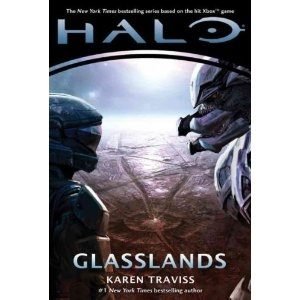Halo: Glasslands by Karen Traviss (book review).
Taken from the cover: ‘The Covenant has collapsed after a long, brutal war that saw billions slaughtered on Earth and her colonies. For the first time in decades, however, peace finally seems possible. But though the fighting’s stopped, the war is far from over: it’s just gone underground. The UNSC’s feared and secretive Office of Naval Intelligence recruits Kilo-five, a team of ODSTs a Spartan, and a diabolical AI, to accelerate the Sangheili insurrection…’
‘Glasslands’ is a tie-in novel for the ‘Halo FPS’ game series that was created by Bungie in 2001.
‘Halo: Glasslands’ isn’t Traviss’ first rodeo when it comes to writing tie-in or military SF. She’s written novels for ‘Star Wars’, ‘Gears Of War’ and was lead writer on the ‘Gears Of War 3’ computer game. She knows her onions when it comes to working in massive game franchises and it shows.
‘Glasslands’ is a bit of a hot drop for a reader. It throws you straight into the story that follows on pretty much directly after the previous Halo novel, ‘Ghosts Of Onyx’ by Eric Nylund, and makes no allowances if you’re not genned up on the ‘Halo’ games and its extensive background. Having said that, if you’re a casual ‘Halo’ player (like wot I is), semi-sentient with the ability to hit the enter key after typing ‘Halo Wiki’ on your intramanet device, you’ll be fine.
‘Glasslands’ feels like a middle book, coming as it does hot on the heels of ‘Ghosts Of Onyx’.
As it takes place after a big battle, the pace is a lot slower than your average, military SF splatterfest, which is realistic, for a given value thereof. The steady pace allows for ample opportunity to ease into the world and setting and get to know the characters and their relationship to each other. Although early on, the pace is possibly a little too leisurely and some of the supporting characters are a bit sketchy, but this improves as the story develops and the pace picks up.
Dr. Catherine Halsey, the genius who initiated the Spartan programme by kidnapping six year-old children to turn into super-soldiers, escapes death only to end up trapped with some of her creations in what is to all intents and purposes, a Dyson Sphere.
The sphere was hidden within the planet Onyx and was built by the Forerunners and stuffed with powerful military technology. These ancient beings have vanished from the universe, leaving all manner of hidden goodies, just waiting to be discovered by humans and their alien enemies. The search for this lost tech provides one of the major plotlines for the novel.
The story focuses on Kilo-Five, a covert ops team brought together by ONI, the Office of Naval Intelligence (they make the CIA look like the WI). Kilo-Five’s job is to help foment civil war between the alien Sangheili, deal with human rebel colonists, find Halsey and hunt for Forerunner artefacts and weapons of mass destruction, particularly the Ringworld Halo arrays that can destroy the galaxy.
Kilo-Five are led by Serin Osman, a failed Spartan who is destined to head ONI and are made up of Orbital Shock Troopers (ODSTs), a Spartan II called Naomi one-zero-one, Black Box a sarcastic AI also known as BB and an academic specialist in Sangheili culture.
This disparate group gel quickly and although it might be a little too quick, Traviss clearly understands military life, how units pull together, how they banter and support each other. This camaraderie comes to the fore when some members of Kilo-Five are forced to face their demons. These small-scale, personal plotlines develop alongside the galaxy spanning storyline and act as a counterpoint to the overarching ‘Halo’ game plot.
We also get to see the story unfold from the viewpoint of the Sangheili, the fearsome ‘hinge-head’ Elites in the form of Jul ‘Mdama and his wife, Raia, which adds an interesting additional layer to the story.
Traviss’ prose is uncluttered, clean and lean. If I have one particular niggle, it’s that I found some of the 20th century slang and cultural references a little at odds with the 26th century setting. It felt like the equivalent of contemporary real world squaddies, referencing Shakespeare and using Elizabethan slang. Not that I’m a fan of inventing words just to sound ‘futuristic’ spug that Chummer! But current, modern day slang felt incongruous at times.
As sure as eggs is eggs, hardcore fans of ‘Halo’ will have a whole catalogue of nit-pics about ‘Glasslands’ from the type of armour worn to the personalities of the characters, but hey, that’s what forums were invented for.
Personally, I don’t mind a little creative, nipping and tucking of in-game ‘canon’ for the sake of creating a compelling plot, ‘Halo’ is an FPS, a great FPS, but it’s not exactly a sacred text.
Traviss manages to work, just about some might say, within the Halo universe and succeeds in adding depth to the setting and aspects of characters that will, I hope, flavour future instalments of the game. Aside of whatever artistic licence the writer may have taken, I couldn’t wait to find out what happened to the characters next and got stuck into ‘The Thursday War’, the next book in the series, as soon as I’d finished ‘Glasslands’.
K T Davies
@KTScribbles
February 2013
(pub: TOR/Forge. 456 page small enlarged paperback. Price: $15.99 (US), $18.50 (CAN). ISBN: 978-0-7653-3040-6)
check out website: www.tor-forge.com






